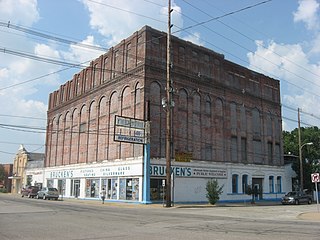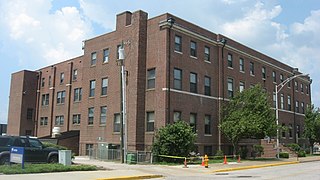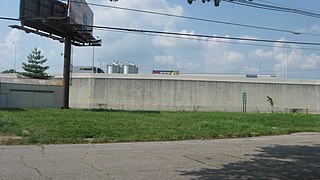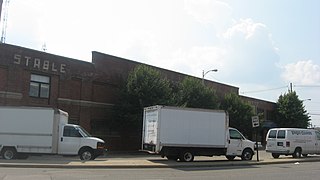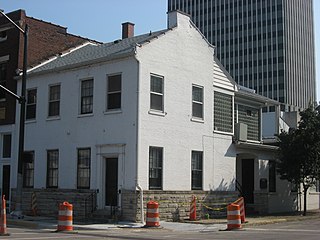Rose Terrace | |
Rose Terrace, July 2011 | |
| Location | 301-313 NW 7th St., Evansville, Indiana |
|---|---|
| Coordinates | 37°58′33″N87°34′12″W / 37.97583°N 87.57000°W Coordinates: 37°58′33″N87°34′12″W / 37.97583°N 87.57000°W |
| Area | less than one acre |
| Built | 1910 |
| Architect | Shopbell & Company |
| Architectural style | Prairie School |
| MPS | Downtown Evansville MRA |
| NRHP reference # | 82000120 [1] |
| Added to NRHP | July 1, 1982 |
Rose Terrace is a housing unit in downtown Evansville, Indiana. The Prairie School style block was designed by the architectural firm Shopbell & Company and built in 1910 as part of a trend to reform crowded living conditions for the working class. [2] :Part 1, p. 25

Downtown Evansville is the central business district of Evansville, Indiana. The boundaries of downtown Evansville have changed as the city has grown, but they are generally considered to be between Canal Street at the south and east, the Lloyd Expressway to the north, Pigeon Creek to the northwest, and the Ohio River to the southeast south and southwest. Downtown Evansville is entirely within Pigeon Township.

Evansville is a city and the county seat of Vanderburgh County, Indiana, United States. The population was 117,429 at the 2010 census, making it the state's third-most populous city after Indianapolis and Fort Wayne, the largest city in Southern Indiana, and the 232nd-most populous city in the United States. It is the commercial, medical, and cultural hub of Southwestern Indiana and the Illinois-Indiana-Kentucky tri-state area, home to over 911,000 people. The 38th parallel crosses the north side of the city and is marked on Interstate 69.

Prairie School is a late 19th- and early 20th-century architectural style, most common to the Midwestern United States. The style is usually marked by horizontal lines, flat or hipped roofs with broad overhanging eaves, windows grouped in horizontal bands, integration with the landscape, solid construction, craftsmanship, and discipline in the use of ornament. Horizontal lines were thought to evoke and relate to the wide, flat, treeless expanses of America's native prairie landscape.
It was listed on the National Register of Historic Places in 1982. [1]

The National Register of Historic Places (NRHP) is the United States federal government's official list of districts, sites, buildings, structures, and objects deemed worthy of preservation for their historical significance. A property listed in the National Register, or located within a National Register Historic District, may qualify for tax incentives derived from the total value of expenses incurred preserving the property.








